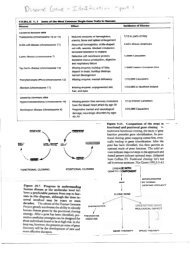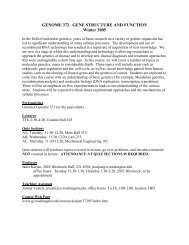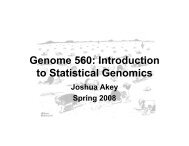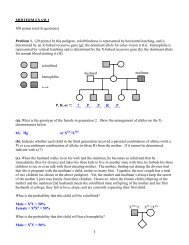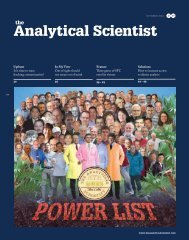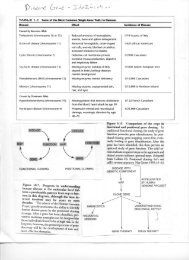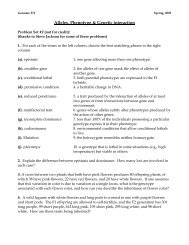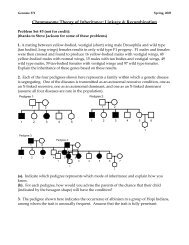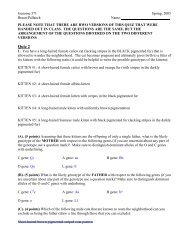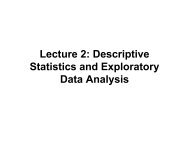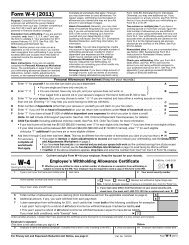lecture notes
lecture notes
lecture notes
Create successful ePaper yourself
Turn your PDF publications into a flip-book with our unique Google optimized e-Paper software.
411-6 2009<br />
-mention other way of getting mutators (Miller review)<br />
Outline:<br />
III. DNA repair<br />
A. Mismatch repair (mutH, mutL, mutS)<br />
B. Oxidative damage repair (mutT, mutY, mutM)<br />
C. SOS response (recA, lexA)<br />
1. excision repair (uvrA, urvB, uvrC, uvrD)<br />
2. recombinational repair (recA)<br />
3. error-prone repair (umuC, umuD)<br />
IV. Transposition<br />
Two levels of redundancy:<br />
1. Process- multiple repair systems act on same DNA damage<br />
2. Informational- DNA double helix<br />
3. SOS response<br />
The repair systems mentioned so far are present all the time because<br />
they deal with mistakes made in replication (mismatch repair) or damage<br />
that occurs all the time (uracil deamination, depurination, base oxidation)<br />
Some special repair systems turned on during time of severe DNA<br />
damage- e.g., exposure to UV light (remember that under normal<br />
conditions, UV exposure minimal)<br />
Best characterized- SOS response<br />
Key components (write on OH)<br />
1. RecA protein- senses DNA damage (pyrimidine<br />
dimers, X-linked DNA, broken DNA)(also involved in<br />
homologous rec)
2. LexA protein- repressor of repair genes<br />
Fig. : top:<br />
Normal case- no damage<br />
bottom: +DNA damage- cleavage of LexA repressor<br />
allows expression of repair genes<br />
Fig Genes repressed (partially or wholly) by LexA<br />
1. Excision repair (uvrA, uvrB, uvrC)<br />
2. RecA gene (recombinational repair)<br />
3. Error-prone repair (umuC, umuD)<br />
4. Cell division inhibitor (SulA=SfiA)<br />
5. lexA gene<br />
Go through one-by-one<br />
1. Excision repair (uvrA, uvrB, uvrC, uvrD)<br />
used to remove bulky adducts in DNA that can't be read<br />
during replication- most important of these are<br />
pyrimidine dimers caused by UV light<br />
Also PHOTOREACTIVATION repairs these- pg 386 in SC2<br />
Fig – mech- UvrAB complex scans for helix distorted b damage- UvrC<br />
displaces UvrA and UvrB cuts 4 nt 3’ of damage. Then UvrC cuts 7 nt 5’<br />
of damage. UvrD is helicase which then removes oligo, and poly I<br />
resynthesizes strand<br />
logic of system similar to MM repair- mistake recognized, SS with damage<br />
excised, SS gap filled in using information on opposite strand<br />
Very important point- both mismatch repair and excision repair show how<br />
redundancy in the DNA double helix is used to prevent mutation. Imagine<br />
if there were no redundancy- if DNA were single-stranded!<br />
2. Recombinational repair = (RecA)- another way to cope with problem of<br />
pyrimidine dimers (Fig. 11-14 in SC2) “Damage tolerance” rather than<br />
true repair- antoher example from replication <strong>lecture</strong> – isomerization at<br />
fork<br />
Fig<br />
3. Error-prone repair or mutagenic repair (umuC, umuD); also dinB as<br />
redundant system<br />
Special system to deal with damage encountered at the replication forksay<br />
if overload the cell with UV damage and get so many pyrimidine<br />
dimers that excision repair and photoreactivation can't remove them all
OH<br />
TT–––––>TT<br />
CT––––>CT<br />
Simple logic- system allows replication fork to replicate anyway- if can't<br />
read base, some such polymerases A residue preferentially (don't mention<br />
mutation generated yet) (different lesion bypass polymerases differ in<br />
what bases they add)<br />
OH- show fork encountering TC dimer and replicating past with AA<br />
system sometimes generates mutations at sites where A inserted (when<br />
original base or bases weren't As)<br />
Why not random? Any advantage to A?<br />
Probably is- back to BOARD<br />
DNA damage often involves pyrimidine dimers from UV<br />
-show how inserting A often corrects damage<br />
OH-Compare replicating past TT dimer with AA always added vs random
Why error prone?- system makes errors when replicating across<br />
unreadable DNA damage. Recent work has shown that system encodes<br />
a special DNA polymerase that substitutes for normal DNA polymerase III<br />
when unreadable DNA encountered in replication. So important that<br />
there’s a second such polymerase dinB as well doing similar thing<br />
EXAMPLE- Induce SOS response including error prone replication without<br />
DNA damage<br />
HOW?- lexA - or recA*<br />
1. 25X increase in lacI- mutation freq<br />
2. Mostly transversions adding A -Fig 9.<br />
Probable explanation return to earlier type of spontaneous DNA damagespontaneous<br />
depurination- loss of A or G. Most common type of<br />
unreadable spontaneous DNA damage (uracils from cyt deamination can<br />
be read)
AFTER BREAK:<br />
Start with lifespan as function of repairmice<br />
die after ca 2 yrs full of cancerous<br />
tumors (short and miserable lives)
OH:<br />
AGAIN- Making mistakes better than stalling replication fork- last ditch<br />
mechanism to avoid death<br />
Recent experiment- asks how permissive error-prone repair really is with<br />
respect to template. Sustitute C12 for phosphate backbone.<br />
OH- ds DNA with gap with C12 opposite gap-Replicate in SOS-induced<br />
cells: get bases added- usually two A’s. So system doesn’t even require<br />
Po4 backbone<br />
ASK Consider error prone repair- mutant: survival and mutation rate after<br />
UV irradiation<br />
OH- plots of mutation frequency and killing<br />
log<br />
UV sensitivity increased- cant rep and dies<br />
survival<br />
no. mutant cells after wild-type UV treatment- Mutation DECREASED!- Why?<br />
frequency<br />
wild-type<br />
UmuCD –<br />
UmuCD–<br />
UV dose<br />
UV dose
Cells that would have given mutants by error prone polymerization die<br />
instead- so get a decrease in mutation rate due to UV-<br />
Error-prone polymerization is Nature's way of saying that being mutant is<br />
better than being dead<br />
Back to BOARD<br />
4. Cell division inhibitor- sulA<br />
blocks cell division until damage repaired- imagine chaos if cell tried<br />
to divide and partition chromosomes with stalled replication forks<br />
Cell<br />
division<br />
ACK!<br />
replication fork blocked<br />
at DNA damage<br />
Draw cell division and FtsZ ring (tubulin-like) and SulÅ inhibition (filament<br />
forms)<br />
5. LexA gene- get more LexA during SOS response, tends to limit<br />
response<br />
Point is that turning off at the right time is as important as turning onafter<br />
all, cell division inhibited, error-prone repair)- require sustained DNA<br />
damage to maintain SOS response
BOARD: Minimizing replication errors<br />
proofreading<br />
mismatch repair<br />
UV induced pyrimidine dimers<br />
excision repair<br />
recombinational repair<br />
error prone repair<br />
photoreactivation (book)<br />
Have multiple systems for correcting same mistakes or damage because<br />
no single system is fully efficient<br />
Infect mice with wild type or LexA noninducible mutant of E. coli, then<br />
treat with ciprofloxacin or rifampicin- get resistant mutants taking over<br />
population only for wt- indicates SOS mutagenesis important for<br />
generation of resistance (the rif resistance is curious one- not due to abt<br />
inducing SOS!)



